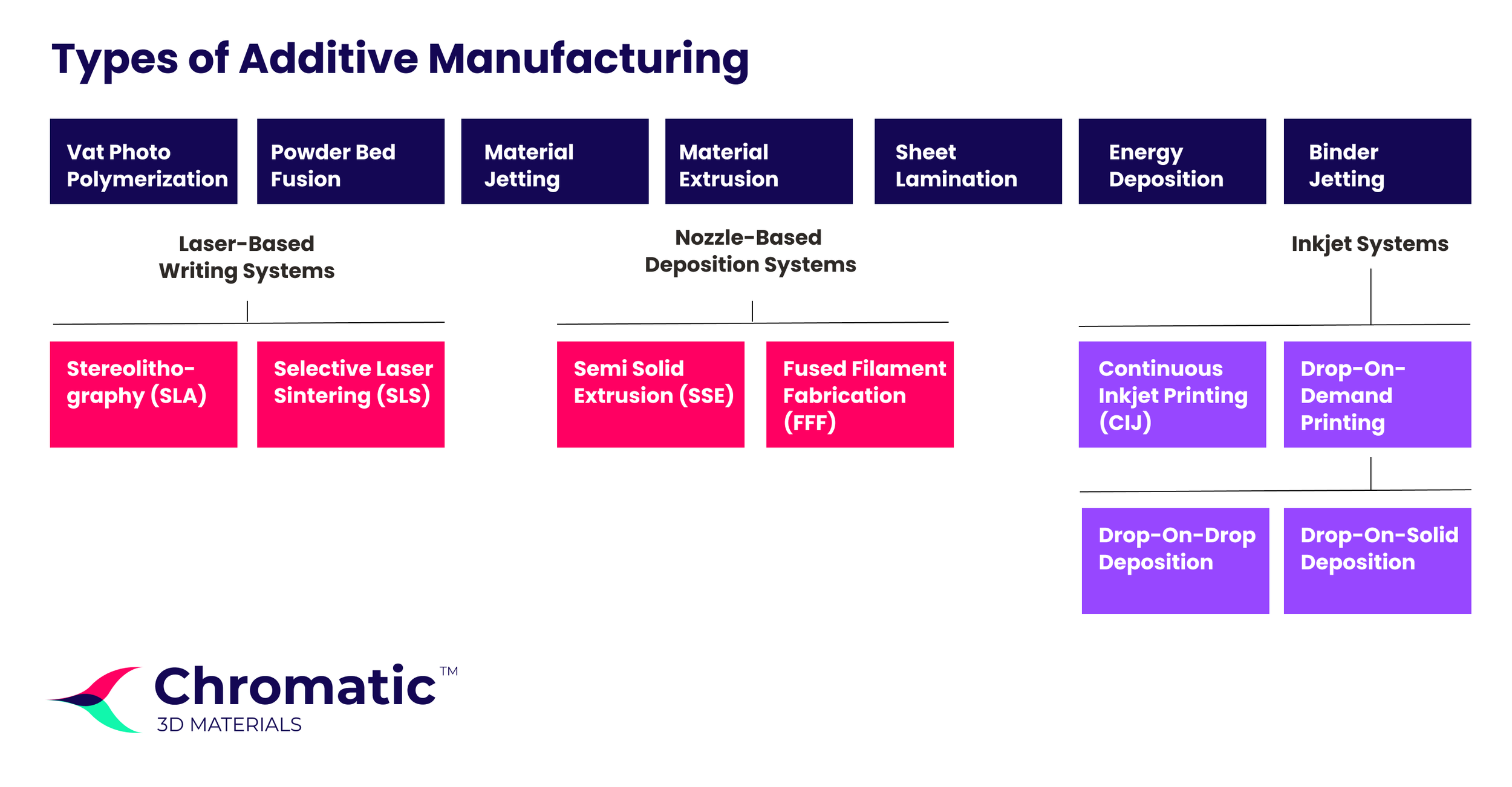Elastomer Additive Manufacturing: Processes & Materials
Author: John Schober, Market Development Lead
Additive manufacturing is less common for elastomers than plastics. There are several reasons why. For one, the material is soft and flexible. It also deforms under stress, making it difficult to manipulate during the 3D printing process. In the case of thermosetting elastomers, it can be challenging to control the curing or crosslinking processes. Plus, elastomers tend to stick to the print bed, which can cause warping and other printing defects.
To overcome these challenges, the additive manufacturing industry has developed specialized 3D-printing technologies and materials specifically for printing elastomers.
3D Printing Methods for Elastomers
Additive manufacturing processes are classified by ISO/ASTM 52900:2021. The chart below explains the various categories of 3D printing.
Among these, only binder jetting, material jetting, vat photopolymerization, powder bed fusion and material extrusion are applicable to elastomers. (There are no commercially available technologies that are classified as energy deposition or sheet lamination for additive manufacturing of elastomers.) The table below provides a high-level comparison of these technologies for elastomers.
| Binder Jetting | Material Jetting | Vat Photopolymerization | Powder Bed Fusion | Material Extrusion | |
|---|---|---|---|---|---|
| Starting Material | Powdered elastomer | Photopolymer resin |
Liquid elastomer resin | Powdered elastomer | Elastomer filament |
| How Layers Are Created | Binding agent deposited on subsequent layers of powdered elastomer creates adhesion | UV light cures resin | Light, e.g. UV or laser, cures resin | Laser or electronic beam melts powder | Filament is melted and extruded |
Elastomeric 3D Printing Materials
Within the subcategory of elastomers, photopolymers, silicone and thermoplastic polyurethanes (TPUs) are the most commonly 3D printed. Photopolymers are typically printed using Material Jetting and Vat Polymerization. Silicones are usually printed using the following technologies: Material Jetting, Powder Bed Fusion or Binder Jetting. TPUs are most commonly printed using Material Extrusion but are also printed using Binder Jetting, Material Jetting, Vat Polymerization and Powder Bed Fusion.
Thermosetting elastomers are an emerging class of materials for 3D printing. The process for printing these materials, called reactive extrusion, falls under the material extrusion category. Reactive extrusion can tune the chemistry of the thermosetting materials to match the desired print speed and geometry of the part. Reactive extrusion yields highly crosslinked materials and enables a wide range of parts to be printed, with the durability of the most common thermosetting materials used in industry.
Thermoset polyurethane grommets printed with reactive extrusion.
Another emerging class of elastomeric materials for 3D printing is thermoplastic elastomers (TPEs). These materials combine the properties of elastomers and thermoplastics, and they consist of chemistries that include both thermoplastic and thermosetting materials. TPEs can stretch and return to their original shape, like elastomers, and can be melted and reshaped, like thermoplastics. They are often used in applications where both flexibility and durability are required, such as in consumer products, automotive parts and medical devices. TPE chemistries are classified into the following categories:
Thermoplastic styrenic block copolymers (SBC or TPE-S)
Thermoplastic elastomer polyolefins (TPO or TPE-O)
Thermoplastic vulcanizates (TPV or TPE-V) or elastomeric alloys (EA)
Thermoplastic polyurethane elastomers (TPU or TPE-U)
Thermoplastic copolyester elastomers (COPE or TEEE or TPE-E)
Thermoplastic polyether block amides (COPA or PEBA or TPE-A)
These are being developed for all of the above additive manufacturing processes.
No solutions are commercially available for printing some of the most commonly specified elastomers, such as EPDM, natural rubber, FKM or HNBR. For many of these, challenges arise in incorporating curing/vulcanization into the AM process in a manner that leads to the desired properties. Accommodating the high viscosity of precursor material(s) are barriers to the availability of these technologies. Organizations such as Chromatic 3D Materials are working on technologies with exciting potential to be commercialized soon.
Further reading
This article is the second in a series about elastomers and additive manufacturing. If you want to learn more about 3D printing with elastomers, read the next article, “The Business Case for 3D Printing Elastomers”. If you’re less familiar with elastomers as a material type, check out the first article in the series “An Introduction to Elastomers: A Type of Flexible & Durable Materials”.



